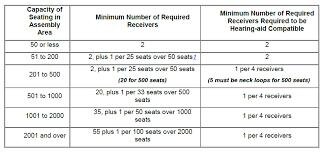ADA Compliant Assistive Listening Systems
ALS Base Station and Receivers
Assistive Listening Systems (ALS) located at Title II and Title III facilities are required to comply with the Americans with Disabilities Act (ADA). This article will discuss the ADA scoping and technical requirements for ALS in State and local government facilities, public accommodations, and commercial facilities. 2010 ADA Standards 219 and 216.10 cover scoping requirements for ALS. Standard 706 covers technical requirements for ALS. The photo above is representative of ALS equipment that can include a base station and receivers.
Scoping Requirements
2010 ADA Standard 219.2, [Assistive Listening Systems] Required Systems, states, “In each assembly area where audible communication is integral to the use of the space, an assistive listening system shall be provided.” In other words, if you must use a microphone in a room to communicate with individuals in the room, an ALS is required. The exception for this requirement is for courtrooms where ALS systems are always required.
Symbol for Hearing Loss
2010 ADA Standard 216.10, [Signs] Assistive Listening Systems, states, “Each assembly area required by [Standard] 219 to provide assistive listening systems shall provide signs informing patrons of the availability of the assistive listening system. Assistive listening signs shall comply with [Standard] 703.5 and shall include the International Symbol of Access for Hearing Loss complying with [Standard] 703.7.2.4.” The graphic on the right is representative of the International Symbol of Access for Hearing Loss.
The exception for this Standard is that where ticket offices or windows are provided, signs shall not be required at each assembly area provided that signs are displayed at each ticket office or window informing patrons of the availability of assistive listening systems.
2010 ADA Standard 219.3, [ALS] Receivers, states, “Receivers complying with [Standard] 706.2 shall be provided for assistive listening systems in each assembly area in accordance with Table 219.3. Twenty-five percent minimum of receivers provided, but no fewer than two, shall be hearing-aid compatible in accordance with [Standard] 706.3.” Table 219.3 is shown below.
The exceptions for this Standard include:
Where a building contains more than one assembly area and the assembly areas required to provide assistive listening systems are under one management, the total number of required receivers shall be permitted to be calculated according to the total number of seats in the assembly areas in the building provided that all receivers are usable with all systems.
Where all seats in an assembly area are served by an induction loop assistive listening system, the minimum number of receivers required by Table 219.3 to be hearing-aid compatible shall not be required to be provided. The graphic below is representative of an assembly area with a continuous induction loop around the seating.
Assembly Area with Inductive Loop for ALS





